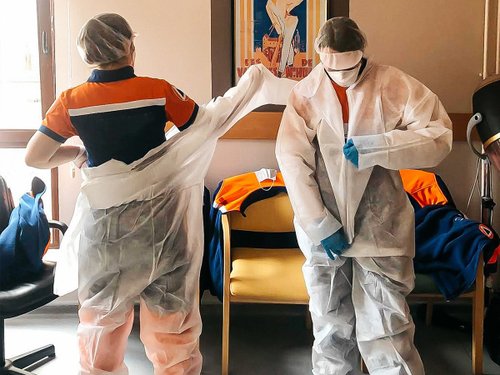Demand & Supply Planners: A Vital Link in the Supply Chain
11 juin 2019
6min

AU
While it might be the first time you’ve ever encountered this job title, a demand & supply planner is the centerpiece of large companies. This important role makes it possible to forecast sales and thus better manage inventory. Grégoire Cauet, a demand & supply planner for the European travel retail arm of L’Oréal, tells us more about the job and its challenges. For him, it’s the perfect start to any career, as the cross-functionality the position entails means that, for the first three or four years, you get an excellent overview of the other professions and departments within your organization.
What’s your educational background and how did you become a demand & supply planner?
Most of my colleagues got a fairly general engineering education with a supply-chain specialization. For this role, recruiters look for candidates with solid scientific reasoning skills, which in France are normally acquired while studying at (specialized) prep schools for entrance to the Grandes Écoles (prestigious institutions of higher education in France that are outside the main framework of the French public university system). My background is different. I got a chemical engineering degree—industrial chemistry, to be precise. After graduation, I joined L’Oréal to oversee product packaging. That’s how I got into the supply chain, as that’s the part of the company that’s involved in transforming products or services, from raw materials to end clients. L’Oréal is an organization that allows for a lot of internal movement, depending on your interests and the opportunities that are available. I worked with people who were developing sales forecasts, who were at the very heart of the organization. I enjoyed it, talked to them a lot about their jobs, and ended up applying to join the team.
“Recruiters want candidates who have solid scientific reasoning skills, which in France are normally acquired while studying for further education. My background is different”—Grégoire Cauet, demand & supply planner for European travel retail at L’Oréal
What responsibilities does a demand & supply planner have?
The job actually involves two main responsibilities.
Firstly, demand planning, which is the long-term part of the job, since it involves projects that last longer than a month and a half. The goal is to generate turnover through sales forecasting. For a product that already exists, this estimate of potential sales is based on previous sales. If the product is brand new, the estimate is based on the benchmarking of similar products that have already been released by competitor brands. This benchmarking is performed in collaboration with members of the marketing department, who know a lot about the market and competitors’ product ranges.
Secondly, there is supply planning, the short-term part of the job. This involves managing inventory and keeping stock surpluses to a minimum in the distribution plant, which means making sure obsolete products aren’t held on to, and distributors don’t run out of stock. This ideal balance is known as the “service rate,” which determines how annual targets are set. It’s also how our performance is evaluated. Inventory management must factor in external constraints, such as shortages in material anywhere around the world, that could potentially slow down production rates and thus force us to increase stock upstream. At the same time, we’re able to reduce stock. We can either order fewer products or launch promotional offers that must be validated by the marketing department. I work in Travel Retail and our points of sale are mostly airport duty-free stores. It’s the people from sales who negotiate with the airports to launch any special offers.
Demand & supply planners can work in both SMEs and larger companies. The only thing that differs, in my opinion, is the distribution of tasks between demand and supply. The supply part plays a bigger role in SMEs because the challenge is to manage inventory and make sure customers’ needs are met. For the demand side of things, the company’s sales history must be long enough to use for identifying trends, or average increases or decreases.

Which departments do you work with every day?
We mostly work with the marketing department, as I’m sure you’ve gathered by now. However, we work a lot with the finance department, too, because they drive all of our sales forecasts. Of course, we also work with people in sales who are in direct contact with our customers (such as in the duty-free stores) and who negotiate things such as communications and the placement of our products within the retail space.
We also meet with the brand’s general manager once a month to present our forecasts, analyses, and strategies. They validate our work and get an overview of the health of the business.

What motivates you most in your role?
I’ve been in this position for two years and I’ve already had two different brand portfolios to manage. I began working with cosmetic products, and I’m now working on what’s referred to as “consumer” products at my company. Changing product portfolios has added a lot of diversity to my role because the quantities sold are not the same. At the moment, the quantities I’m dealing with are much larger, and so it’s easier to work out the sales forecasts. This is what we call “large numbers theory.”
Finally, I really enjoy travel retail because you’re in contact with people all over the world.
“Changing product portfolios has added a lot of diversity to my role because the quantities sold are not the same”—Grégoire Cauet
What are the everyday challenges you encounter?
First of all, it’s a fast-paced job, which doesn’t bother me at all, but I think the working hours might deter someone coming from outside the company. Our role more or less comes into play at the end of the supply chain and is closely connected to the customer, unlike the sales team, who are involved at the beginning of the chain, and the marketing team, who are in the middle. We are the final link before the point of sale. As a consequence, a lot rests on our shoulders, such as inventory, product availability, and product launches.
Secondly, we are frequently in contact with people from other services, and we might not always speak the same language and have the same priorities. For us, it’s absolutely about ensuring stock levels are healthy, whereas the priority for marketing might be something like a big product launch. So we need the right communication tools to make ourselves heard, and sometimes we need to to find a compromise in what we do.
“We are the final link before the point of sale. As a consequence, a lot rests on our shoulders”—Grégoire Cauet
What tools do you need to master?
We use mathematical formulas and Excel every day. We also have global SAP software that gives us an overview of inventory and is used for accounting purposes, such as invoicing and orders. Finally, to create our sales forecasts, we use FuturMaster, which is a tool that converts sales history into a mathematical curve.
Fortunately, we can teach ourselves how to use these tools on the job and through internal training. No schools offer training for this, at least not to my knowledge.

What qualifications are required?
I’d say that the key requirement is to have solid interpersonal skills. The role of a demand & supply planner involves cross-functional management every day, since each member of the project team has his or her own added value and brings their own specific expertise. Tensions must be avoided at all costs and relationships prioritized in an environment that is often stressful.
Then there’s the question of rigor. We have to be meticulous, because our actions have a major impact on the business. We must deal with numbers all day, and the consequences can be huge if we aren’t vigilant.
Finally, I think we have to be curious. Monitoring is an integral part of the business. We need it to understand the global, economic, and social context—it informs the decisions we make. As for myself, I listen to the radio a lot and read (the weekly French newspaper) Courrier International because I love geopolitics. Once we’ve gathered information, we share our findings internally via Teams, a sharing tool that ensures everyone is up to speed and able to respond promptly.

How do you see this role evolving in the future?
It will involve more statistical processing.
The aim is to succeed in making centralized forecasts, which means having a central entity that carries out sales forecasts at an international level and then splits them between the various subsidiaries. Centralizing all this data at an international level will allow us to be much more precise. It will be more effective than having data from each country that never matches up.
Plus, there will be more business analysis.
The notion of “demand sensing” is becoming increasingly popular. The method, which is still at the research stage, combines sales forecasting with machine learning. It’s used to gather the maximum amount of data, to find out who’s buying what in real time.
You then need to process the data and react quickly to adapt your stock levels accordingly. The human aspect must not be left out of the picture, though. IT tools are a great help, but if something unexpected happens, teams must step in, adjust the configuration, and increase or decrease the sales forecasts.

What’s your advice for being successful in your profession?
Make sure you know the products you’re selling because that will have genuine consequences for the sales forecasts. Communication with the marketing team is invaluable, because you’ll learn all about the products and the context surrounding their launches.
Translated by Andrea Schwam
Photos: WTTJ
Follow Welcome to the Jungle on Facebook and sign up for our newsletter to receive our articles every week

Inspirez-vous davantage sur : Mobilité pro : secteurs et métiers

What if college isn’t the only route to success
As the US suffers from a shortage of plumbers and electricians, becoming a tradesperson can be very lucrative. So why do so few Americans consider it?
11 janv. 2023

5 big data careers that just keep growing
“Big data” is currently one of the most sought-after areas of tech expertise. But what are the different roles you could take?
27 avr. 2022

Product owner vs product manager – What’s the difference?
Product managers and product owners are multidisciplinary roles that create new products and improve ones that already exist... Huh?
17 mars 2022

Industries of the future: how do you prepare for careers that don’t exist?
You’d have to be a talented psychic to be able to describe the jobs of the future, especially with the world changing so rapidly.
10 janv. 2022

How Covid is changing the job of epidemiologists
Dr Kavita Trivedi explains how her job as an epidemiologist has changed since Covid, as companies hire disease experts to make their offices safe.
11 sept. 2020
La newsletter qui fait le taf
Envie de ne louper aucun de nos articles ? Une fois par semaine, des histoires, des jobs et des conseils dans votre boite mail.

Vous êtes à la recherche d’une nouvelle opportunité ?
Plus de 200 000 candidats ont trouvé un emploi sur Welcome to the Jungle.
Explorer les jobs